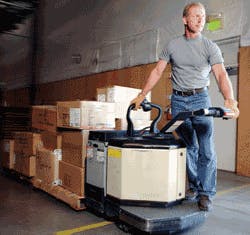Warehouse Ergonomics/Tips And Techniques To Decrease Injury Risk
The approximately 705,000 workers in the warehousing and storage sector of industry perform a wide variety of tasks, including labeling items, breaking bulk shipments down into smaller components, inventory control, light assembly, order entry and fulfillment, packaging, pick and pack, price marking and ticketing and transportation arrangement. Occupations vary as well, including industrial truck and tractor operators; laborers (such as those who move freight, stock and materials by hand); shipping and receiving clerks; and stock clerks and order fillers. But they all have one thing in common: a high rate of strains and sprains.
In 2012, according to the Bureau of Labor Statistics, the U.S. warehousing and storage subsector reported a total recordable rate of 5.5 injuries per 100 full-time workers. Serious injuries – those involving days away from work, job restriction or transfer – occurred at a rate of 3.9 injuries per 100 workers. Musculoskeletal injuries occurred twice as frequently in the warehousing and storage industry as in general private industry, with 78.1 and 35.5 injuries respectively per 10,000 workers. Additionally, in 2012, injuries in exposure categories such as falls, slips and trips and overexertion (including overexertion in lifting or lowering) were higher in the warehousing and storage industry than in general private industry. Incidences of strains, sprains and tears in the warehousing and storage industry were 80 per 10,000 full time workers.
These injuries most often affected the back, upper extremities and knees, and most likely were caused by exposure to material handling or other ergonomic-related risk factors including high applied force, awkward postures, short cycle times or long work durations without adequate breaks.
Here are some common ergonomic principles that can be applied in warehouses in order to identify risk factors and develop ways to reduce musculoskeletal injury risk.
Application of Ergonomic Principles in Warehouses
Warehouse tasks can be divided into three broad categories: placing and picking; packing; and receiving and shipping.
Placing and picking tasks – Placing and picking tasks often include the placement and retrieval of items from shelving or bins within the warehouse or storage system. These tasks can be performed in a number of ways and require varying amounts of equipment. Some examples include:
- Placing or picking large or heavy items using a forklift or other lift mechanism from a floor location.
- Using an order picker to place or pick items from various heights.
- Using a cart to manually place or pick items from the ground level.
Risk factors that might present themselves during the picking and placing relate to the way products are handled. These can include the weight of items, the body postures and frequency while handling these items.
Some things that can be done to reduce the risk factors related to injuries from placing and picking for manual or mechanized tasks include:
- Ensure that the individual is aligned with the item's storage location in a way that does not require twisting of the back.
- When possible, position the individual so that the activity (lifting, pulling, pushing, placing, etc.) occurs between knee and shoulder height. Heavy or awkward items should be positioned between knuckle and elbow height.
- Use proper lifting techniques.
- Utilize mechanical assistance (hoists, pulleys, lifts, etc.) when handling heavy or awkward items.
- Ensure that the wheels on carts are well-maintained and in proper working order. Poorly maintained carts increase the force needed to maneuver them.
- Do not overload carts. Ensure that the weight on carts is within the design specifications of the cart. Additionally, ensure that items on the cart are not above the individual's field of vision. Items that are stacked at high levels can restrict the field of vision and limit the maneuverability of the cart and the individual, thus increasing the risk of bumping into items or rolling over items that might be near the floor and also could cause awkward body postures.
- Ensure that safety checks are performed regularly for all mechanical equipment and that the equipment is in proper, safe working order.
- Securing large or heavy items in shipping crates or on pallets. This might require the use of shrink-wrapping equipment or other methods to secure the shipment.
- Packing items in boxes and including appropriate packing materials to secure the item during shipment.
- Completing necessary paperwork for shipment.
Risk factors that might be present during packing tasks relate to the way products are received, packed and shipped. These can include the weight of items, the body postures when handling them and the frequency of handling items.
- Some things that can be done to reduce the risk factors related to injuries from placing and picking items include:
- Position the orientation of the product and the worker in a way that does not require twisting or extended reaches by the worker.
- Work as close to the neutral posture as possible. Neutral posture includes a straight neck, straight back with the curves naturally supported, shoulders straight down, elbows at a right angle and wrists straight.
- Minimize forces that are applied. These forces can include pinching, gripping, pushing and pulling while performing tasks like taping, filling packages with fill material, retrieving packing slips and other needed paperwork and other tasks.
- Use proper lifting techniques.
- When possible, minimize the need to carry items by using carts, conveyors and roller tables.
Receiving and shipping tasks – Receiving and shipping tasks often include pallet breakdown or pallet construction. These tasks may be performed manually and include the breakdown of pallets containing similar items or pallets of mixed items. Some examples include:
- Securing large or heavy items in shipping crates or on pallets. This may require the use of shrink-wrapping equipment or other types of materials to secure the shipment.
- Packing items in boxes and including appropriate packing materials to secure the item during shipment.
- Completing necessary paperwork for shipment.
Risk factors that can be present during packing tasks relate to the way products are received, packed and shipped. These can include the weight of items, the body postures of the workers and frequency of handling these items.
Some things that can be done to reduce the risk factors related to injuries from receiving and shipping tasks include:
- Use proper lifting techniques.
- Use mechanical assist when possible.
- Place the load between knees and shoulders when possible. Heavy weights should be placed between knuckle and elbow height.
Tips for Managers and Engineers
Warehouse and storage managers and engineers often play a role in the placement of items and the development of standard operating procedures. During these activities, basic ergonomic principles should be followed in order to minimize ergonomic risk factors such as awkward body postures and high-applied forces. Some ergonomic principles to keep in mind are:
- Place frequently used items on shelving that easily is accessed by a worker between his or her knees and shoulders.
- Place large, heavy or bulky items between knees and shoulders (the heaviest ones should be placed between knuckles and elbows).
- Ensure that employees are properly trained.
- Implement rolling conveyors to move product between areas when possible.
- Use mechanized devices such as pickers, pallet jacks, fork trucks and scissor lifts when possible.
- Implement mechanisms so that pallet loading can be performed between knuckle and elbow height. This can be done through the use of platforms or pallet lifts.
Investigate Causes and Implement Interventions
Injuries in the warehouse and storage industry significantly are higher than those in other industries. For some injuries, the rates are more than double those found in other industries. As a result, investigating the causes of injuries and implementing ergonomic interventions to minimize the risk associated with activities is important.
Jeffrey Fernandez is the managing principal at JFAssociates Inc., based in the Washington, D.C. area. He has an M.S. and Ph.D. in industrial engineering from Texas Tech University, is a registered professional engineer and a certified professional ergonomist and is known for his expertise in occupational ergonomics and classical industrial engineering. Fernandez is a member of the EHS TODAY Editorial Advisory Board. Brandy Farris Ware is a director of operations and senior managing engineer at JFAssociates Inc., based in the Phoenix area. She holds bachelor's and master's degrees in industrial engineering with an emphasis in applied occupational ergonomics, and is working on her Ph.D. in business organization and management. She is a certified professional ergonomist and a certified Six-Sigma black belt. Ware is known for her expertise in the application of industrial engineering and applied occupational ergonomics principles in a wide variety of industrial settings.


